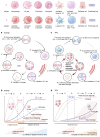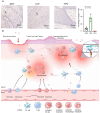Pyodermatitis-Pyostomatitis Vegetans: The Role of Langerin Deficiency in Disease Pathogenesis
- PMID: 40565944
- PMCID: PMC12194030
- DOI: 10.3390/jcm14124198
Pyodermatitis-Pyostomatitis Vegetans: The Role of Langerin Deficiency in Disease Pathogenesis
Abstract
Background/Objectives: Pyodermatitis-pyostomatitis vegetans (PPV) is a rare, chronic inflammatory mucocutaneous disorder. However, the etiology of PPV remains controversial. Methods: A review of online PPV case studies from PubMed, Wanfang database, Web of Science, and books has been performed. Comparative analysis of langerin expression has been conducted to verify the hypothesis summarized from the literature review by Immunohistochemistry (IHC). Results: A total of 63 patients were analyzed across 5 reviews, 44 case reports, and 1 book chapter. Our findings revealed distinct immunological alterations in PPV patients. Innate immunity was upregulated, marked by increased neutrophil and eosinophil counts and enhanced macrophage activity. Adaptive immunity was suppressed, with reduced dendritic cell (DC) numbers and activity and diminished adaptive immune responses. We hypothesize that langerin was a critical factor, contributing to adaptive immune suppression and a compensatory innate immune hyperactivation. Conclusions: We propose the hypothesis that langerin expression on Langerhans cells (LCs) plays a pivotal role in PPV pathogenesis by shifting the immune balance toward innate hyperactivation at the expense of adaptive immunity.
Keywords: Pyodermatitis–pyostomatitis vegetans; adaptive immune; dendritic cells; innate immune; langerin.
Conflict of interest statement
The authors declare no conflicts of interest.
Figures




Similar articles
-
Systemic pharmacological treatments for chronic plaque psoriasis: a network meta-analysis.Cochrane Database Syst Rev. 2021 Apr 19;4(4):CD011535. doi: 10.1002/14651858.CD011535.pub4. Cochrane Database Syst Rev. 2021. Update in: Cochrane Database Syst Rev. 2022 May 23;5:CD011535. doi: 10.1002/14651858.CD011535.pub5. PMID: 33871055 Free PMC article. Updated.
-
Structured treatment interruptions (STI) in chronic unsuppressed HIV infection in adults.Cochrane Database Syst Rev. 2006 Jul 19;2006(3):CD006148. doi: 10.1002/14651858.CD006148. Cochrane Database Syst Rev. 2006. PMID: 16856117 Free PMC article.
-
Systemic pharmacological treatments for chronic plaque psoriasis: a network meta-analysis.Cochrane Database Syst Rev. 2017 Dec 22;12(12):CD011535. doi: 10.1002/14651858.CD011535.pub2. Cochrane Database Syst Rev. 2017. Update in: Cochrane Database Syst Rev. 2020 Jan 9;1:CD011535. doi: 10.1002/14651858.CD011535.pub3. PMID: 29271481 Free PMC article. Updated.
-
Signs and symptoms to determine if a patient presenting in primary care or hospital outpatient settings has COVID-19.Cochrane Database Syst Rev. 2022 May 20;5(5):CD013665. doi: 10.1002/14651858.CD013665.pub3. Cochrane Database Syst Rev. 2022. PMID: 35593186 Free PMC article.
-
Stem cell transplantation for induction of remission in medically refractory Crohn's disease.Cochrane Database Syst Rev. 2022 May 13;5(5):CD013070. doi: 10.1002/14651858.CD013070.pub2. Cochrane Database Syst Rev. 2022. PMID: 35556242 Free PMC article.
References
-
- Fde A.M., Rosa D.J., Carvalho M.T., Castañon M.C. Pyodermatitis-pyostomatitis vegetans: Case report and review of medical literature. An. Bras. Dermatol. 2011;86:S137–S140. - PubMed
Grants and funding
- 82370974/National Natural Science Foundation of China
- LCYJ2023-DL-2/the Fund of the Research and Develop Program, West China Hospital of Stomatology, Sichuan University
- 82201074/National Natural Science Foundation of China
- CIFMS, 2019-I2M-5-004/the CAMS Innovation Fund for Medical Sciences
- WT_/Wellcome Trust/United Kingdom
LinkOut - more resources
Full Text Sources

